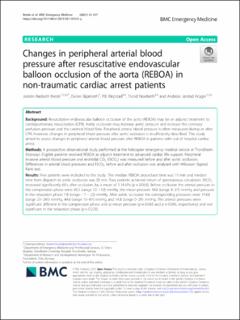| dc.contributor.author | Brede, Jostein Rødseth | |
| dc.contributor.author | Skjærseth, Eivinn Årdal | |
| dc.contributor.author | Klepstad, Pål | |
| dc.contributor.author | Nordseth, Trond | |
| dc.contributor.author | Krüger, Andreas | |
| dc.date.accessioned | 2022-02-10T14:34:32Z | |
| dc.date.available | 2022-02-10T14:34:32Z | |
| dc.date.created | 2021-12-15T23:20:13Z | |
| dc.date.issued | 2021 | |
| dc.identifier.citation | BMC Emergency Medicine. 2021, 21 (1), . | en_US |
| dc.identifier.issn | 1471-227X | |
| dc.identifier.uri | https://hdl.handle.net/11250/2978304 | |
| dc.description.abstract | Background Resuscitative endovascular balloon occlusion of the aorta (REBOA) may be an adjunct treatment to cardiopulmonary resuscitation (CPR). Aortic occlusion may increase aortic pressure and increase the coronary perfusion pressure and the cerebral blood flow. Peripheral arterial blood pressure is often measured during or after CPR, however, changes in peripheral blood pressure after aortic occlusion is insufficiently described. This study aimed to assess changes in peripheral arterial blood pressure after REBOA in patients with out of hospital cardiac arrest. Methods A prospective observational study performed at the helicopter emergency medical service in Trondheim (Norway). Eligible patients received REBOA as adjunct treatment to advanced cardiac life support. Peripheral invasive arterial blood pressure and end-tidal CO2 (EtCO2) was measured before and after aortic occlusion. Differences in arterial blood pressures and EtCO2 before and after occlusion was analysed with Wilcoxon Signed Rank test. Results Five patients were included to the study. The median REBOA procedural time was 11 min and median time from dispatch to aortic occlusion was 50 min. Two patients achieved return of spontaneous circulation. EtCO2 increased significantly 60 s after occlusion, by a mean of 1.16 kPa (p = 0.043). Before occlusion the arterial pressure in the compression phase were 43.2 (range 12–112) mmHg, the mean pressure 18.6 (range 4–27) mmHg and pressure in the relaxation phase 7.8 (range − 7 – 22) mmHg. After aortic occlusion the corresponding pressures were 114.8 (range 23–241) mmHg, 44.6 (range 15–87) mmHg and 14.8 (range 0–29) mmHg. The arterial pressures were significant different in the compression phase and as mean pressure (p = 0.043 and p = 0.043, respectively) and not significant in the relaxation phase (p = 0.223). Conclusion This study is, to our knowledge, the first to assess the peripheral invasive arterial blood pressure response to aortic occlusion during CPR in the pre-hospital setting. REBOA application during CPR is associated with a significantly increase in peripheral artery pressures. This likely indicates improved central aortic blood pressure and warrants studies with simultaneous peripheral and central blood pressure measurement during aortic occlusion. Trial registration The study is registered in ClinicalTrials.gov (NCT03534011). | en_US |
| dc.language.iso | eng | en_US |
| dc.publisher | BMC | en_US |
| dc.rights | Navngivelse 4.0 Internasjonal | * |
| dc.rights.uri | http://creativecommons.org/licenses/by/4.0/deed.no | * |
| dc.title | Changes in peripheral arterial blood pressure after resuscitative endovascular balloon occlusion of the aorta (REBOA) in non-traumatic cardiac arrest patients | en_US |
| dc.type | Peer reviewed | en_US |
| dc.type | Journal article | en_US |
| dc.description.version | publishedVersion | en_US |
| dc.source.pagenumber | 157 | en_US |
| dc.source.volume | 21 | en_US |
| dc.source.journal | BMC Emergency Medicine | en_US |
| dc.source.issue | 1 | en_US |
| dc.identifier.doi | 10.1186/s12873-021-00551-y | |
| dc.identifier.cristin | 1969176 | |
| cristin.ispublished | true | |
| cristin.fulltext | original | |
| cristin.qualitycode | 1 | |

